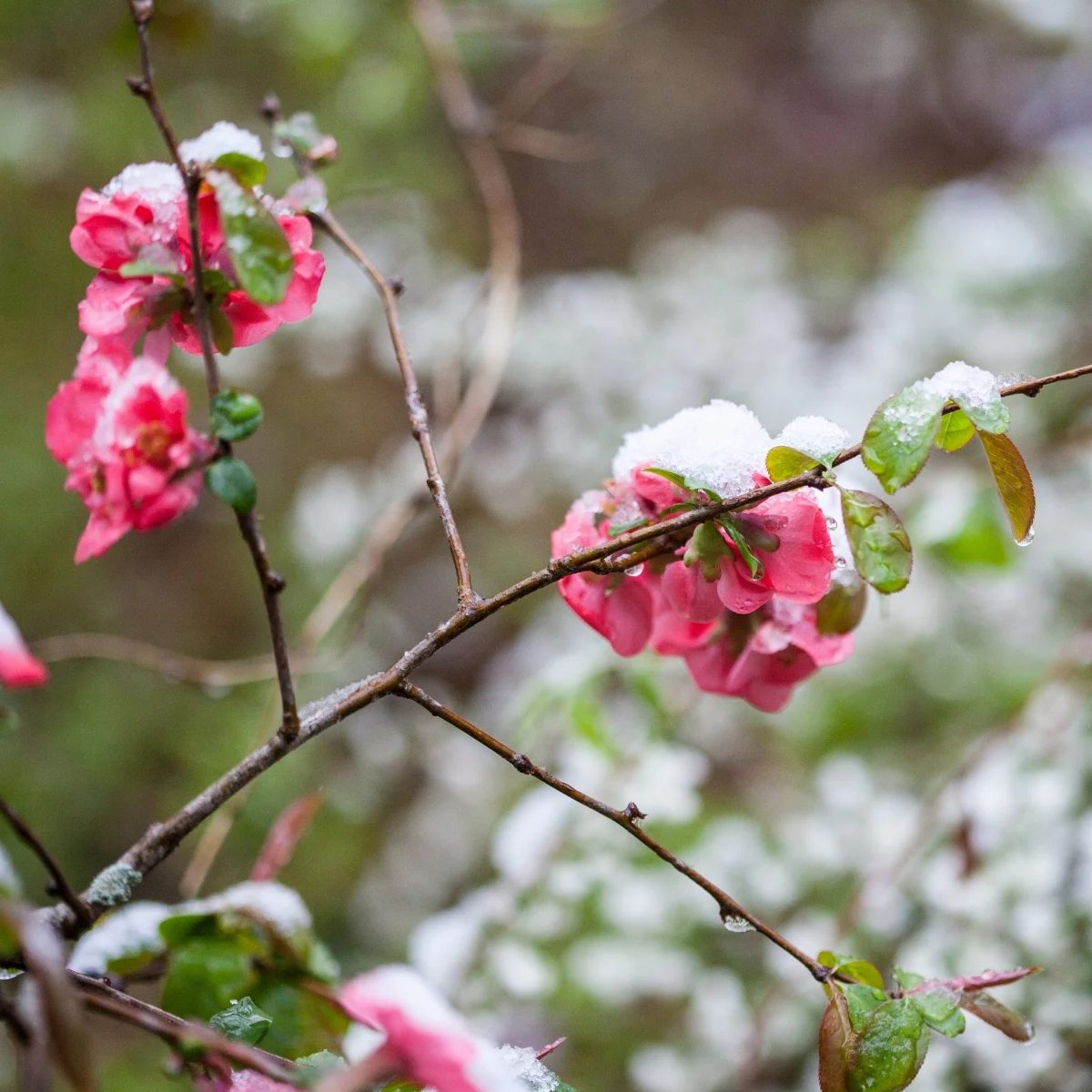Flowering quince can cheer up your landscape throughout the year with beautiful blooms in late winter and berries in summer and fall!

Planting flowering quince in your garden is a great way to add vibrant color early in the year. These hardy, long-lived shrubs are among the first flowers to bloom in winter, bursting forth with a profusion of tiny red, pink, or white petals on cane-like branches, followed by reddish and then dark green leaves later in spring.

Another benefit of flowering quince is the attractive and edible berry. In summer and fall, the bush is covered with small, aromatic yellow fruits that look like tiny Asian pears. The fruits are high in pectin and can be used for making jams and jelly, but they are not edible raw.
This post contains affiliate links for your convenience. Purchases made through these links may earn me a small commission at no additional cost to you.
Flowering Quince Cultivars
Flowering quince is a different species from fruiting quince, Cydonia oblonga, which produces larger edible fruits but less dramatic flowers. If you want the flowering species, look for Chaenomeles speciose.
You can find numerous cultivars of flowering quince, differing in size, thorniness, and flower color. Flower colors range from red to salmon to orange and white.

Full-sized plants can reach 8 feet in diameter and 10 feet tall, and the dense tangle of branches can make an outstanding and impenetrable hedge while also providing a habitat for birds and other critters.

You can also find dwarf varieties of flowering quince for borders and low barriers. Dwarf plants top out in height at about 6 feet.
If you don't want the danger of thorns, look for one of the newer varieties with minimal thorns, such as "Double Take Pink" or "Double Take Scarlet." These varieties are also fruitless, so you won't have messy berries to clean up at the end of the season.

Where to Plant Flowering Quince
Plant flowering quince in full sun to get the best display of blossoms. However, it can also grow in partial shade, but flowering might not be as profuse. In deep shade, it is unlikely to flower much or at all.
Choose a location where the eye-catching flowers are highly visible for the short bloom time in late winter. However, remember that many varieties have an abundance of sharp thorns, so pick a spot away from pathways and sidewalks where this feature could be a problem, or choose a thorn-free type.

Flowering quince is tolerant of many soil types as long as the ground drains well. You can let the numerous branches sprawl or prune them as an espalier to grow along a retaining wall or fence.
This shrub thrives in city gardens with exposure to smog and is moderately tolerant of drought once established. However, avoid planting in areas with high wind exposure because the branches are somewhat fragile.
When to Plant Flowering Quince
The best time to plant a flowering quince is in late fall or winter while the plant is dormant. An early winter planting will likely reward you with a display of flowers in the first season. Flowering quince grows quickly once it is transplanted.

How to Plant a Flowering Quince
Prepare a planting hole twice the size of the root ball of the potted plant. If you have heavy clay soil, add in compost to improve drainage around the roots.
Flowering quince can grow in slightly acidic to slightly alkaline soil. It's a good idea to do a soil pH test and amend the soil as needed to get it into the correct pH range if required.

Then, place the plant into the hole with the potting soil surface at the same level as the garden soil, backfill the spot, and water the area thoroughly.
Caring for Flowering Quince
In the first year after transplanting, give the plant regular water during dry weather to help it establish a healthy root system. After that, water when the top inch of soil dries out, but moist soil in late winter helps ensure abundant flowers. A layer of mulch can help retain moisture, keep weeds down, and provide nutrients.
This shrub does not need much fertilizer. A small application of 10-10-10 fertilizer on the soil surface or a layer of high-quality compost once a year before flowering is all it's likely to need.
Flowering quince only blooms for about two weeks, but you can cut bud-covered branches, put them in a vase, and force them to bloom indoors for extra enjoyment of the colorful blossoms.

Because of its sprawling, thin branch structure, flowering quince often does best with yearly pruning. However, remember that the flowers grow on last year's wood. Therefore, it's best to prune after the blossoms have faded but before mid-summer.
Prune out dead and broken branches and cut some of the oldest wood to ground level to keep the plant looking tidy and increase light and air circulation in the shrub's interior. If you want fruit, remember that heavy pruning can reduce fruiting next season, and prune lightly.
Check out these other winter blooming plants!







Carrie Chandler
Wednesday 19th of July 2023
Really interesting been a while since I've seen a quince plant
Lisa
Saturday 29th of July 2023
I just purchased two double orange quince and leaves falling off...nice size plants-small. Climatizing but 80-90's so keeping in pots on my porch shade till weather not so brutal. Watering daily to ensure getting moisture. Water runs right through so shallow clear yogurt lid under each.🙏🏡🇺🇸 spent small fortune on these five various plants. I do have a green thumb☺️
Lisa
Saturday 29th of July 2023
@Carrie Chandler,
Christie Merrill
Wednesday 26th of July 2023
@Carrie Chandler, the house I live in has several flowering quince, planted by the people who lived here before me.